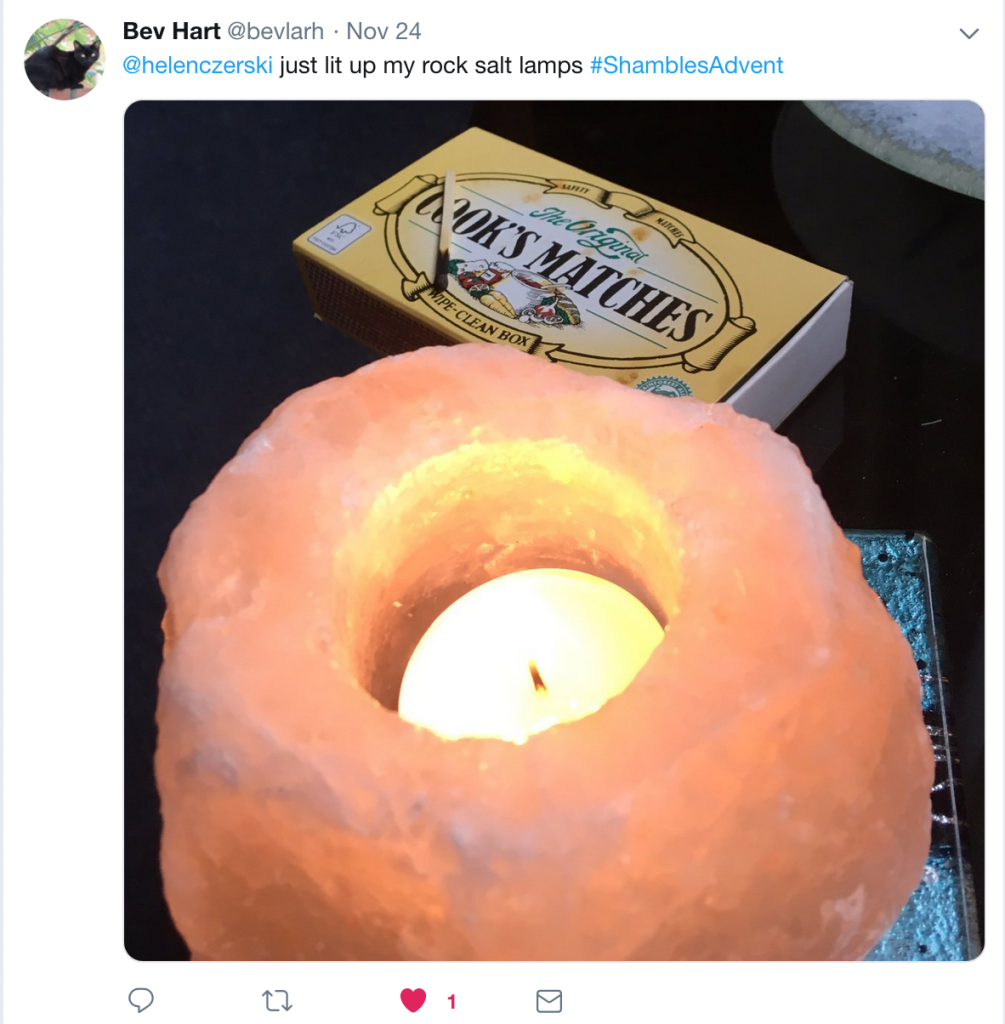Day 15 - Shambles Advent
Blog in a Teacup by Dr Helen CzerskiDay 15 – @bevlarh
Every day until Christmas Dr Helen Czerski will be finding some cool, hidden science in pics of people’s every day lives. To get involved, tweet your pic to @helenczerski and @cosmicshambles with the hashtag #ShamblesAdvent

It’s the time of year when candles start appearing everywhere, and this picture from @bevlarh reminded me of a counter-intuitive way to re-light a candle just after you’ve blown it out. You need the candle to have been burning for a little while, so it’s got a nice stable flame and at least a bit of a pool of wax beneath. Get another match ready to light, and then blow the candle out as quickly and cleanly as you can. Strike the new match straight away, but instead of touching the match to the wick, hold it about 5cm above. The candle flame will start burning again at the wick below, even though the match never touched it. You can play around with this – you might be able to get it to work with the lit match quite a bit higher, depending on the type of candle. But what’s going on?
Candles are nice and solid, so we tend to assume that when we burn a candle, we’re burning solid fuel. But that’s not the case. A candle is a self-sustaining mini-conveyer belt from solid to liquid to gas. The match that lights the candle (when you light it normally) not only provides a spark, but also enough heat to melt the wax near the wick. The liquid wax is then drawn up the wick, just like a towel soaking up a spill. And once the candle flame is nice and hot, the wax evaporates to form a gas. The flame is the point where that gas mixes with oxygen from the surrounding air and burns to produce even more heat. Some of that heat is used up in heating up more wax from below, which keeps the cycle going. And then the hot air with the combustion leftovers rises in a straight column, because it’s less dense than the surroundings. Eventually, it mixes in with the air and cools down.
When you first blow the candle out, that conveyer belt is still going. There’s enough heat to keep the wax in the wick liquid, and to evaporate it at the top. That produces nice warm gaseous fuel (even though it hasn’t burned yet), and the hot air from the last of the burning is still rising, so fuel-rich air from the candle is pulled into the rising column. When you bring your new lit match into that column higher up, there’s plenty of fuel and oxygen to burn, and it quickly burns all the way back down to the wick and provides the spark to re-light the wax at the wick. And off your candle goes again. You just need to provide the spark before the conveyer belt has switched off.
Read all of Helen’s other #ShamblesAdvent entries here
The Cosmic Shambles Network relies on your support on pledges via Patreon so we can continue to provide great, new, exciting content without the need for third party ads or paywalls.
For as little as $1 a month you can support what we do and get some great rewards for doing so as well. Click the Patreon logo to pledge or find out more.
 Dr Helen Czerski is a physicist, first and foremost, but she’s acquired a few other labels along the way: oceanographer, presenter, author and bubble enthusiast. A regular on The Cosmic Shambles Network, she has also presented a number of acclaimed documentaries for the BBC and her first book, Storm in a Teacup, which looked at the physics of every day things, was a bestseller. Recently she was awarded the prestigious William Thomson, Lord Kelvin Medal and Prize from the Institute of Physics.
Dr Helen Czerski is a physicist, first and foremost, but she’s acquired a few other labels along the way: oceanographer, presenter, author and bubble enthusiast. A regular on The Cosmic Shambles Network, she has also presented a number of acclaimed documentaries for the BBC and her first book, Storm in a Teacup, which looked at the physics of every day things, was a bestseller. Recently she was awarded the prestigious William Thomson, Lord Kelvin Medal and Prize from the Institute of Physics.
If you would like to reuse this content please contact us for details
Subscribe to The Cosmic Shambles Network Mailing list here.


